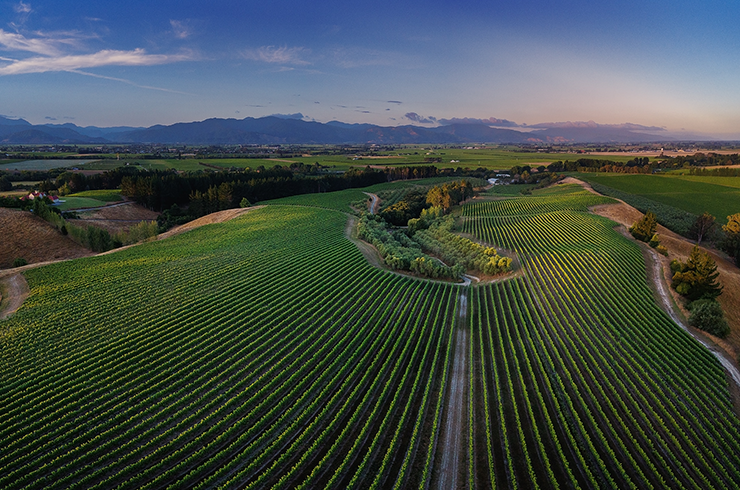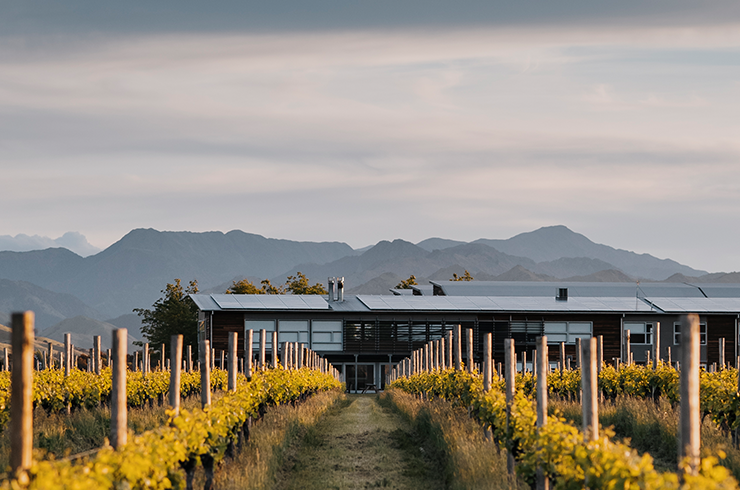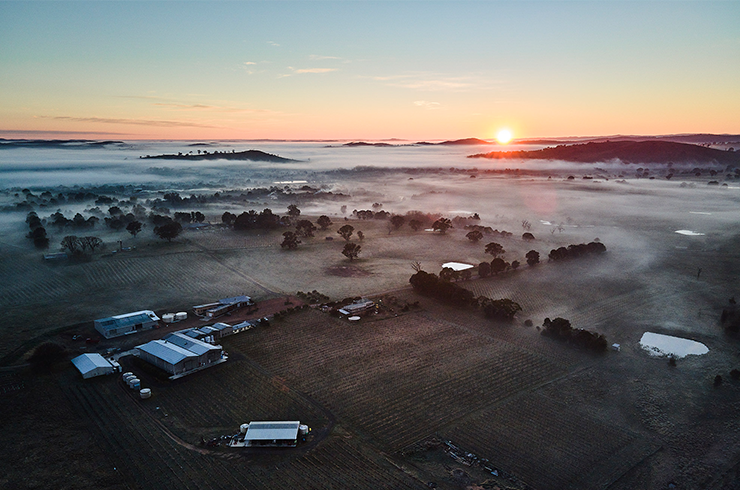Dubbed the “Melbourne dress circle” by James Halliday, the five wine regions surrounding the Victorian capital produce some of Australia’s finest pinot noir. So, what can we expect from each, and how do the diverse climates translate in the bottle? We chat to producers in Geelong, Gippsland, Macedon, the Mornington Peninsula and Yarra Valley about their homegrown pinot.
“Bellarine pinots are, in general, more red-fruited on the nose and show more sweet fruit on the palate, while tannins and acid tend to be less at similar sugar ripeness,” he says. “If whole bunches are used in the ferment, you’re more likely to see a green herbal edge to the wines. Overall, there’s a lovely pure fruit expression coupled with a supple palate structure, reminiscent of wines you may see from the Mornington Peninsula.”
Ray explains that Moorabool Valley pinots lean toward a denser, more earthy expression. “They’re often more tannic, less overtly fruity, and have higher levels of acid [especially in the cooler years]. When whole bunches are included, the wines show less green edges on the nose and instead are even more earthy and sanguine.”
Discover Geelong pinot noir.
As winemaker Alastair Butt of Lightfoot & Sons says, the prevailing thing about Gippsland, for pinot, in particular, is the mild climate. “Pinot is a delicate wine style, and we see that it really responds to these milder coastal conditions,” he says.
Despite varying fruit flavour profiles and winemaking influences, Alastair believes Gippsland pinots have a common thread. “They have this lovely, delicate texture about them,” he says. “They’re not high in alcohol, and they’re not cooked. Some have lovely fragrant fruit, while others have more structure and tannin profile.”
Discover Gippsland pinot noir.
Matt Harrop moved to Curly Flat in 2017, but has been producing pinot from the region since 2005. “One of the nicest things about growing pinot up here is the vines switch on late in the day, and then when the sun is low in February and March, they turn off quite early, so we get a long growing season,” he says. “Pinot loses vitality and vibrancy when it gets too heat-affected, but we can pick quite ripe with decent alcohol, and still have fresh flavours and vibrant characters.”
While Matt describes Macedon pinot as typically having a “vibrancy, purity, freshness and vitality with good natural acidity,” he’s quick to point out there is great diversity across the region.
Discover Macedon Ranges pinot noir.
On the palate, Geraldine says this translates to “a lot of red fruit and spicy flavours, and, in general, finer, lighter tannins than some of the places that can get both hotter and colder. The colours tend to be a bit lighter than some of those really cold regions too, and those mild conditions and the prevalent cool breezes mean we get this gentle development of phenolics.”
Discover Mornington Peninsula pinot noir.
Across the region, you’ll find great variation in elevation and soil type. Steve explains that from the mid-Yarra subregions of Gruyere and Tarrawarra, which are on fairly “hungry” eroded grey clays, “the flavours are rich and dark, almost brooding, the colours are a little stronger, and the tannins are pronounced and fresh. Gladysdale in the Upper Yarra delivers more high-toned musk and exotic characters. The flavours are ‘prettier’, they’re highly perfumed, the tannins are more fine-boned and the wines more silky.”
Discover Yarra Valley pinot noir.
This article is an edited extract from Halliday magazine.
Geelong
Southwest of Melbourne, the Geelong wine region straddles two distinct areas: the coastal vineyards of Bellarine Peninsula, and Moorabool Valley northwest of the Geelong city centre. According to Ray Nadeson of Lethbridge Wines, the influence of altitude, wind patterns and the moderating effect of the sea have a huge impact on the region’s pinot noirs.“Bellarine pinots are, in general, more red-fruited on the nose and show more sweet fruit on the palate, while tannins and acid tend to be less at similar sugar ripeness,” he says. “If whole bunches are used in the ferment, you’re more likely to see a green herbal edge to the wines. Overall, there’s a lovely pure fruit expression coupled with a supple palate structure, reminiscent of wines you may see from the Mornington Peninsula.”
Ray explains that Moorabool Valley pinots lean toward a denser, more earthy expression. “They’re often more tannic, less overtly fruity, and have higher levels of acid [especially in the cooler years]. When whole bunches are included, the wines show less green edges on the nose and instead are even more earthy and sanguine.”
Discover Geelong pinot noir.
Gippsland
With a GI that stretches over 500km from Phillip Island to the NSW border, the Gippsland climate is perhaps the most difficult to define, encompassing the rugged coastline of the Bass Strait, fertile farmlands surrounding Sale, and Lakes Entrance at the foot of the Alpine National Park. The Gippsland Lakes have a moderating effect on the weather, keeping temperatures even and delivering a steady growing period.As winemaker Alastair Butt of Lightfoot & Sons says, the prevailing thing about Gippsland, for pinot, in particular, is the mild climate. “Pinot is a delicate wine style, and we see that it really responds to these milder coastal conditions,” he says.
Despite varying fruit flavour profiles and winemaking influences, Alastair believes Gippsland pinots have a common thread. “They have this lovely, delicate texture about them,” he says. “They’re not high in alcohol, and they’re not cooked. Some have lovely fragrant fruit, while others have more structure and tannin profile.”
Discover Gippsland pinot noir.
Macedon Ranges
Directly north of Melbourne, the Macedon’s high elevation makes this region the mainland’s coldest. It is intensive viticulture here, with winter snows, low yields and small holdings that require much of the vineyard work to be done by hand.Matt Harrop moved to Curly Flat in 2017, but has been producing pinot from the region since 2005. “One of the nicest things about growing pinot up here is the vines switch on late in the day, and then when the sun is low in February and March, they turn off quite early, so we get a long growing season,” he says. “Pinot loses vitality and vibrancy when it gets too heat-affected, but we can pick quite ripe with decent alcohol, and still have fresh flavours and vibrant characters.”
While Matt describes Macedon pinot as typically having a “vibrancy, purity, freshness and vitality with good natural acidity,” he’s quick to point out there is great diversity across the region.
Discover Macedon Ranges pinot noir.
Mornington Peninsula
South of Melbourne, the Mornington Peninsula lies on an extinct volcanic ridge sandwiched between Port Phillip Bay, Bass Strait and Western Port Bay. Geraldine McFaul of Willow Creek has been working in the region for 24 years and says the cool maritime influence is the biggest regional driver. “We have mild fluctuations in diurnal temperatures, and that smaller range means you don’t have low malic acid when the wines get harvested. A lot of the wines have high malate and high natural acidity, and the fruit is very fragrant,” she says.On the palate, Geraldine says this translates to “a lot of red fruit and spicy flavours, and, in general, finer, lighter tannins than some of the places that can get both hotter and colder. The colours tend to be a bit lighter than some of those really cold regions too, and those mild conditions and the prevalent cool breezes mean we get this gentle development of phenolics.”
Discover Mornington Peninsula pinot noir.
Yarra Valley
An hour’s drive east of Melbourne, the cool-climate Yarra Valley is prime pinot noir country. Steve Flamsteed of Giant Steps describes the pinots coming out of the Yarra as lighter, highly fragrant wines defined more by the nose than the palate. “I often say we make ballet dancers rather than bodybuilders,” Steve says. “Our young wines are full of perfume, energy and freshness on release, but will deliver a layer of savoury complexity to anyone prepared to cellar them. Despite being so seductive and pretty on the nose, there’s a latent silky structure to the palate that can be quite deceptive.”Across the region, you’ll find great variation in elevation and soil type. Steve explains that from the mid-Yarra subregions of Gruyere and Tarrawarra, which are on fairly “hungry” eroded grey clays, “the flavours are rich and dark, almost brooding, the colours are a little stronger, and the tannins are pronounced and fresh. Gladysdale in the Upper Yarra delivers more high-toned musk and exotic characters. The flavours are ‘prettier’, they’re highly perfumed, the tannins are more fine-boned and the wines more silky.”
Discover Yarra Valley pinot noir.
This article is an edited extract from Halliday magazine.
Latest Articles
-
Wine Lists
The 50 most popular wines of 2025
just now -
Wine Lists
A snapshot of top New Zealand wines (all rated 91 points and above)
1 day ago -
Behind the label
Taste Aotearoa: Get to know these five New Zealand wineries
1 day ago -
Wine Lists
Just in: 14 newly reviewed wines to try this December
2 days ago





